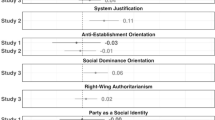Abstract
The aim of this article is to highlight that some economic correlates of Islamist political violence matter differently when they are considered in a specific path. In order to show this, we use a Generalized Mixed Effects Regression Tree analysis. This methodology combines the structure of random effects models for longitudinal data with the flexibility of a tree regression method. The latter is a nonparametric method for estimating a regression function.



Similar content being viewed by others
Notes
The “Manchester Manual” was found by British police and was considered to be Al Qaeda’s handbook way of operating [http://justice.gov/sites/default/files/ag/legacy/2002/10/08/manualpart1_2.pdf].
Unfortunately, the GTD does not distinguish between transnational and domestic attacks.
By using a negative binomial model and a traditional Hausman test, we do not reject the validity of an RE specification.
We estimate Eq. (2) by using the penalized quasi-likelihood method suggested by Hajjem et al. (2010). In this case, the error term becomes \(v^{-1}\left( {\mu _{it}^b } \right) \varepsilon _{it}\), where \(v^{-1}\left( {\mu _{it}^b } \right) \) is a power function for the relationship between the variance and the predicted means.
For further details on conditional inference trees, see Hothorn et al. (2006).
References
Abadie A (2006) Poverty, political freedom and the roots of terrorism. Am Econ Rev Pap Proc 96:50–56
Azam JP (2012) Why suicide—terrorists get educated, and what to do about it. Public Choice 153:357–373
Benmelech E, Berrebi C, Klor EF (2012) Economic conditions and the quality of suicide terrorism. J Polit 74:115–128
Boehmer C, Daube M (2013) The curvilinear effects of economic development on domestic terrorism. Peace Econ Peace Sci Public Policy 19:359–368
Breiman L, Friedman JH, Olshen RA, Stone CJ (1984) Classification and regression trees. Wadsworth Inc, Monterey
Brockhoff S, Krieger T, Meierrieks D (2016) Heterogeneous terrorism: determinants of left-wing and nationalist-separatist terrorism in Western Europe. Peace Econ Peace Sci Public Policy 22:393–401
Bueno de Mesquita E (2005) The quality of terror. Am J Polit Sci 49:515–530
Campante FR, Chor D (2014) The people want the fall of the regime: schooling, political protest, and the economy. J Comp Econ 42:495–517
Caruso R, Schneider F (2013) Brutality of Jihadist terrorism: a contest theory perspective and empirical evidence in the period 2002–2010. J Policy Model 35:685–696
Choi S (2010) Fighting terrorism through the rule of law? J Confl Resolut 54:940–966
Easterly W, Gatti R, Kurlat S (2006) Development, democracy, and mass killings. J Econ Growth 11:129–156
Enders W, Hoover GA, Sandler T (2016) The changing nonlinear relationship between income and terrorism. J Confl Resolut 60:195–225
Fielding D, Shortland A (2010) An eye for an eye, a tooth for a tooth, political violence and counter-insurgency in Egypt. J Peace Res 47:433–447
Freytag A, Kruger J, Meierrieks D, Schneider F (2011) The origins of terrorism: cross-country estimates of socio-economic determinants of terrorism. Eur J Polit Econ 27(S1):S5–S16
Fu W, Simonoff JS (2015) Unbiased regression trees for longitudinal data. Comput Stat Data Anal 88:53–74
Gelpi C, Avdan N (2015) Democracies at risk? A forecasting analysis of regime type and the risk of terrorist attack. Confl Manag Peace Sci. doi:10.1177/0738894215608998
Hajjem A, Bellavance F, Larocque D (2010) Generalized mixed effects regression trees. Cahier du GERAD G-2010-39
Hegre H, Ellingsen T, Gates S, Gleditsch NP (2001) Towards a democratic civil peace? Democracy, civil change, and civil war 1816–1992. Am Polit Sci Rev 95:17–33
Hothorn T, Hornik K, Zeileis A (2006) Unbiased recursive partitioning: a conditional inference framework. J Comput Graph Stat 15(3):651–674
Krueger AB, Maleckova J (2003) Education, poverty and terrorism: is there a causal connection? J Econ Perspect 17:119–144
Li Q (2005) Does Democracy promote or reduce transnational terrorist incidents? J Confl Resolut 49:278–297
Lopes AM, Machado JAT, Mata ME (2016) Analysis of global terrorism dynamics by means of entropy and state space portrait. Nonlinear Dyn 85:1547–1560
Maleckova J, Stanisic D (2013) Does higher education decreases support for terrorism? Peace Econ Peace Sci Public Policy 19:343–358
Piazza J (2011) Poverty, minority economic discrimination, and domestic terrorism. J Peace Res 48(3):339–353
Sandler T (2014) The analytical study of terrorism: taking stock. J Peace Res 51:257–271
Sela RJ, Simonoff JS (2012) RE-EM Trees: a data mining approach for longitudinal and clustered data. Mach Learn 86:169–207
Author information
Authors and Affiliations
Corresponding author
Appendix: Stability analysis
Appendix: Stability analysis
Table 3 reports the leave-one-out results for all the regression trees presented in this article. Column 1 contains the name of the splitting variable and the number identifying the corresponding node. Column 2 reports the number of times in which the splitting variable did not appear in the validation exercise. Column 3 reports the number of leave-one-out replications in which the splitting variable appeared with a different threshold. Columns 4 and 5 give the relative incidence of numbers found in Columns 2 and 3, respectively. According to our validation tests, Fig. 1 is extremely stable; we identified the same splitting variables and their critical values in all leave-one-out tests. In 24 out of 446 trees, we also found an additional splitting variable after node 2. In particular, for highly educated countries, the expected number of attacks was 60.3 for countries with an inflation rate less or equal than 4.28 and was 29.9 for countries with an inflation rate higher than 4.28. The leave-one-out validation test for Fig. 2 revealed that node 5 fails to be identified 4.9% of the times; node 6 has a failure rate of 8.3%; the failure rate for node 8 is 4.5%; and node 9 is not selected 6.3% of times. Vice versa, the remaining nodes are always included in the tree, although in a few cases (less than 1.8%), their threshold values are slightly different. Finally, Fig. 3 is robust even if democracy is not selected 6.5% of the times. Vice versa, both per capita income and education always enter the tree.
Rights and permissions
About this article
Cite this article
Bassetti, T., Caruso, R. & Schneider, F. The tree of political violence: a GMERT analysis. Empir Econ 54, 839–850 (2018). https://doi.org/10.1007/s00181-016-1214-1
Received:
Accepted:
Published:
Issue Date:
DOI: https://doi.org/10.1007/s00181-016-1214-1




